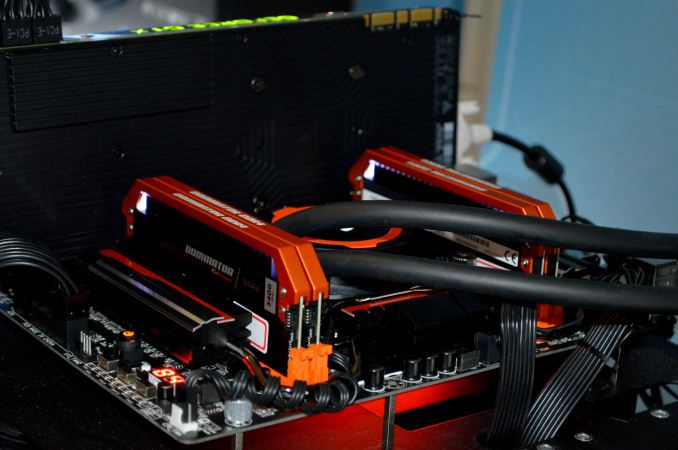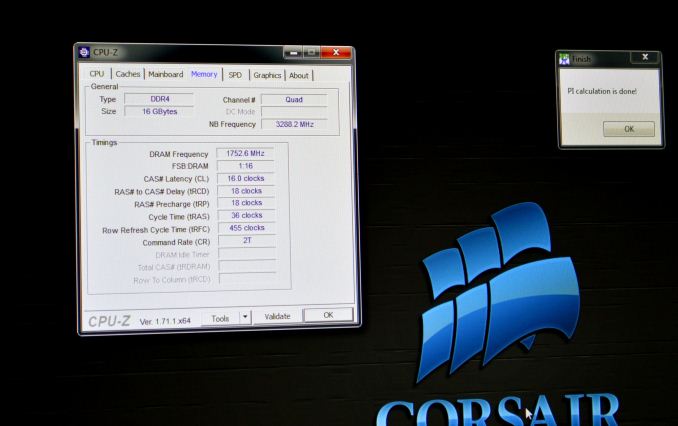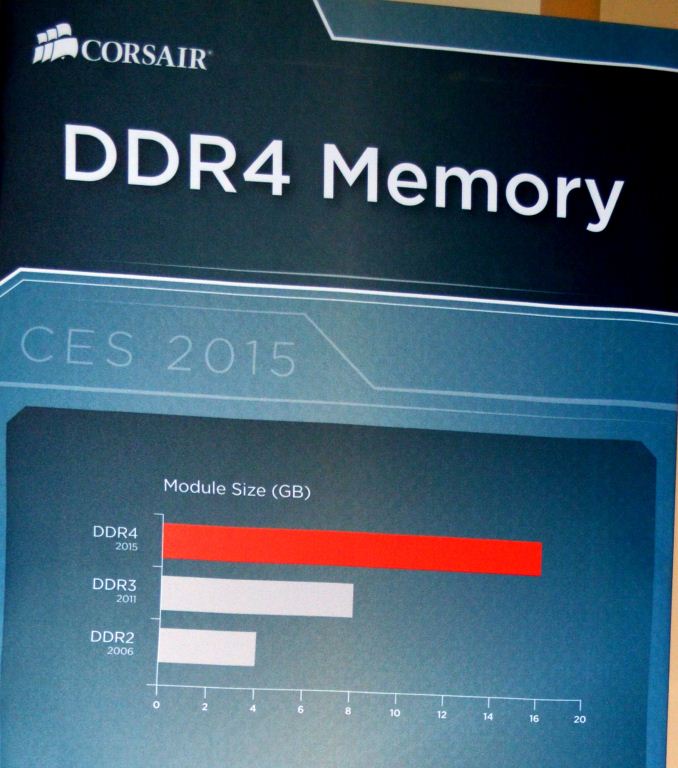Corsair Show DDR4-3400, also mentions 16GB UDIMMs?
by Ian Cutress on January 13, 2015 1:46 PM EST
Aside from the formal press releases from Corsair already announcing the new Carbine 100R, the Hydro H110i GT all-in-one liquid cooler, the HG10 N780 GPU Bracket and their new flash storage options, at their suite there was a couple of interesting things worth discussing regarding DRAM. A small portion of the suite had the recently released GIGABYTE X99-SOC Champion (which we have reviewed), but plugged in to this was a set of orange DDR4-3400 memory.
Up until this point, Corsair had released DDR4-3200 (we have a kit of this in to test) at $740 for 4x4GB to DDR4-3333 at $910, but DDR4-3400 pushes the margin out a bit more. With most DRAM, binning for higher speed hits the law of diminishing returns – you have to bin more ICs to get the high speed. As a result, these modules will be pretty expensive, and because it is X99 which needs four modules to reach quad channel bandwidth, a user has to buy all four. At the suite, they even had them running with a small overclock to DDR4-3500:
This sets them up to be very expensive. They are currently on Corsair’s website for $999.99 for a 4x4GB kit. To put that into context, two sets of 4x8GB DDR4-2133 C13 will run at just over $1000 combined, making these modules almost 4x the cost per GB than the base JEDEC frequency memory. These DDR4-3400 modules are set at 16-18-18, which is looser than JEDEC at 2133, but indicates that both primary sub-timings and frequency are tight compared to each other. Compatibility for this kit is so far only listed as with the X99-SOC Champion.
While the kit was impressive and did catch my eye, the following wall image caught my attention more:
Here it explicitly states that a module size of 16GB is coming to DDR4 in 2015. Unfortunately no other information could be crowbarred out of Corsair regarding time frame or pricing, but we were able to speak with a memory manufacturer who said it should be coming in the near future. We will be working hard with Corsair to secure some testing kits if they pop up, but it means that soon we should (hopefully) start to see 128GB UDIMM arrangements on X99. It might also mean another round of BIOS updates to help support a full 8x16GB configuration. These would most likely start at DDR4-2133, as this would have the highest yields.













31 Comments
View All Comments
azazel1024 - Tuesday, January 13, 2015 - link
If my budget allows it, I am considering Skylake, but honestly for my server, which is running a G1610 on a H67 chipset motherboard. More for the features than anything, but I am also hoping with a newer chipset and newer processor, that it might just be able to push down my idle power a couple more watts, while also leveraging a lot more "new stuff". For instance, having more than 2 6Gbps SATA ports would be nice, as I can't run my 2 disk RAID0 array and my boot SSD all on 6Gbps, which is an inconvenience (sure, the HDDs themselves can't saturate SATAII, but the DRAM caches on them CAN, so there could be a small gain if the array could live on the 6Gbps ports). Maybe/possible switching up that boot SATAIII 60GB SSD for something like a PCIe based m.2 60-64GB SSD could be nice too. Then 2x4GB of DDR4 or even 2x8GB of DDR4 for lower power and higher bandwidth would be nice.Lastly, the low end of the core line has actually gotten some pretty reasonable improvements if you look at Sandy through Haswell and sadly Broadwell is getting skipped. So even if I stuck with a Celeron Skylake CPU, odds are decent I could get a reasonably good bump in CPU performance (maybe 10-15%) as well as a decent bump in GPU performance (which on a mostly headless server, isn't terribly important, but as the GPU DOES get leverage for some tasks, doesn't hurt). That and I may finally jump up to a higher level chip than a Celeron. Depending on price/performance/power consumption I may finally look at a low end i3...and who knows, maybe by Skylake we'll see quad core get pushed in to i3 territory with dual core being a Celeron and Pentium thing, with i5s gaining hyperthreading and i7's gaining hexacore. One can hope/dream.
It would be nice to see i3 having both hyperthreading AND turboboost, it would make my decision that much easier.
My desktop with its i5-3570@4GHz really doesn't leave too much on the table. I can't see upgrading that until maybe Broadwell-E or more likely Skylake-E hits the market, as I'd like a CLEAR increase in performance, though if the regular i7's gain hexacore with Skylake, that might be an excuse, I mean a reason, to upgrade. As it stands, I know new technologies come along all the time, but I am thinking/hoping for USB3.1 in the chipset natively the itteration after Skylake. It isn't crucial to have it native in my desktop (and I'd imagine by the time the 10 series chipsets hit, board manufacturers will have lots of add-on controllers for 2-4 ports of USB3.1), but it would be nice to have.
name99 - Tuesday, January 13, 2015 - link
THAT's an interesting idea!One way Intel could try to juice up the relevance of Skylake in world where Sandy and successors are already pretty damned powerful and (for most purposes) low enough power might be to switch from the current 2 core/4 core devices for mobile/desktop to something like
i3=3 cores, i5=4 cores, i7=6 cores...
Marketing might love that as well, leaving 2 cores for the Celeron/Pentium really low-end stuff.
Laststop311 - Tuesday, January 13, 2015 - link
I'm running an almost 5 year old core i7-980x at 4.2ghz and i skipped upgrading to haswell-e in favor of getting the 2nd generation 55" oled from LG for 3000 dollars. Even after 5 years my pc is still not slow enough to upgrade. The only reason I have to upgrade is for additional features that weren't part of the x58 chipset. The 8 core would def boost my video encoding but is it really worth it to spend over 2000 on a new cpu mobo and expensive ddr4 ram just to shave a few minutes off encoding? Broadwell-e is going to be a boring 14nm shrink of haswell-e so i'll be sitting tight till skylake-e, by that time skylake will have made ddr4 more mainstream and prices should be a lot better for ddr4 and having pci-e 4.0 will be a nice reason to go for it and usb 3.1 should be in the chipset for skylake-e. Maybe all the pci-e 2.0 will get upgraded to 3.0 once 4.0 is out which would be a nice bonus too bumping sata express to 16gb/s instead of 10.Because the standards everything will be running on are so different I will need new ssd's and new gpu so I will probably turn my current pc into a super powerful nas rather than re use the case and psu since i will have to buy new parts for everything else basically it wont save much money and will be more useful keeping it together.
MikhailT - Tuesday, January 13, 2015 - link
5% is impressive for a yearly or even bi-yearly update, heck, even 2% is impressive. What you should do is compare 3 years worth of innovation looks like. Compare Skylake to an Intel CPU 3 years ago and you'll be impressed of how far they came.We're never going to see any more than 3-5% for a single CPU generation again, we're reaching the limits of how much we can pull from the current technologies and it is going to take longer and longer to scale down the nm processes.
TiGr1982 - Tuesday, January 13, 2015 - link
I know and I don't complain, actually. For example, with no more than 4 x86 instructions-wide decoder, found in all Intel Core designs, this situation of slow recent improvements with Intel's x86 performance per clock was unofficially named "the limit of Intel's superscalar" by. e.g., Boris Babaian, who was to do with Intel himself in the last 10 years.In three generations, however, 1.05^3 = 1.16, which is worth considering.
Nagorak - Friday, January 30, 2015 - link
A 16% improvement is next to nothing. Not even remotely worth considering upgrading over.Nagorak - Friday, January 30, 2015 - link
I have to disagree that 5% is in any way impressive. Back in the 90s if your computer was 2-3 years old it was probably half as fast as a new machine. Obviously those days are long behind us now, but even so, seeing a 20% improvement over the course of like 4 years is pretty lame.The newer processors aren't fast enough for many of us to even justify upgrading, especially when games tend to rely so heavily on GPUs nowadays. I've been running my i5 2500K since the end of 2011. I ran it for two years at stock and then cranked up the overclock to 4.6 GHz, which put it close to being on par with newer processors.
I don't see myself upgrading my CPU for another two or three years. There's just no point. Who knows, maybe by the time I'm ready to upgrade AMD will be back in the game (yeah, I know, it's a long shot).
Aslan7 - Wednesday, January 14, 2015 - link
Core i7 3770K @4.2 GHZ when I bought it new. I've had the CPU pegged at 100% utilization since. I only have 16GB (2x 8GB I knew it wouldn't be enough when I bought it, so I was prepared for the upgrade) of memory and after 3 tabs in IE 9, 50-75 in Chrome, Vuze, Steam, World Community Grid and 1 modern AAA game I'm using somewhere between 12-15+ GB of memory. Sometimes I even hit 16GB plus and fell the computer paging things in and out on the HD. I'm hitting the ceiling now. I need 32GB right now, and I want 64GB. I'd like to keep a 4GB VM open all the time and have the option to run some content creation stuff without having to kill the game. There's a program available now that will load a game to a ram disk before play and unload it when you're done. X99 and the new processor architectures are appealing for the increased IPC, but what keeps me away from the upgrade are ram costs. I figure DDR4 needs another 18 months on the market for the prices to become reasonable.Impulses - Wednesday, January 14, 2015 - link
Yeah at those costs I'm not upgrading any time soon, I recognize that the $60 or so I paid for my 16GB (4x4) of DDR3 bordered on ridiculous, but I haven't paid over half a grand for RAM in over a decade... I'm sure prices will come down, I'm just doubtful how fast that'll be with desktops in continued decline.TheinsanegamerN - Friday, January 16, 2015 - link
just wait until ddr4 comes to laptops. that'll be more than enough to push prices down.